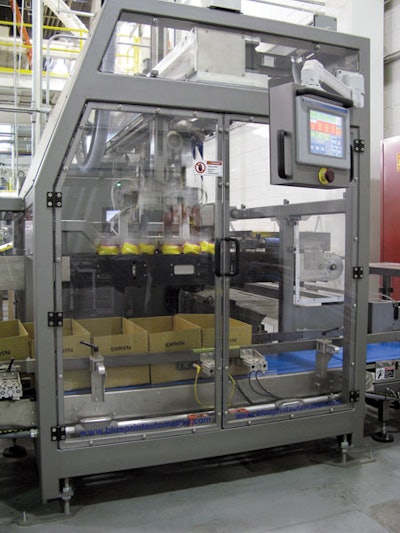
Companies typically introduce a new package format due to marketing guidance based on consumer preferences. For Del Monte Pet Foods, Decatur, AL, the motivation to convert to pouch packaging was entirely different: The carton used for its Meow Mix cat food was being discontinued. Thus Del Monte was compelled to completely change the product’s packaging—and its production operations. All this needed to be done quickly and seamlessly so as not affect a very loyal customer base, according to Del Monte.
Yet, the new pouch production operation landed as squarely on its feet as a dropped cat. Anchoring everything is a robotic case-loading system from Blueprint Automation (www.blueprintautomation.com). And thanks to the automation, the line—started up in September 2007 and consisting of nine machines—is essentially a one-operator line, though a shift foreman who oversees several production lines serves as backup help. “The operator simply sits back and watches it run,” says Del Monte controls engineer Sam Torres, who led the pouching line project. The carton line was run by two operators.
The day of our visit, Del Monte Pet Foods packaged 18-oz stand-up pouches of Kitten “Li’l Nibbles” Meow Mix brand cat food. Pouches are conveyed from the horizontal pouching machine in bottom-leading fashion toward case loading in single file at a rate of 70/min, though the entire front portion of this line could handle 120 pouches/min, according to Torres.
Ahead of the robotic case loader, pouches are inspected by an x-ray machine rather than a metal detector—that’s due to the metallized pouch film used—and then by a checkweigher. Both machines are from Mettler Toledo (www.us.mt.com), a supplier that Torres has been familiar with for years. “I trust the company’s equipment and reliability,” he says. “It is very good equipment.”
An inclined conveyor elevates the pouches from a 34-in. height to the 54-in. infeed height of the case loader. Along the way, the pouches travel over a “conditioning” section that helps settle and even out the pouch contents, in effect flattening them for more efficient packing.
Rather than a “hard automation” case packer, Del Monte selected a flexible robotic system due to the challenges of employing a wraparound-style case, which typically requires the packs being cased to have some rigidity.
“It’s impressive how fast it can move, and manipulate the pouches,” says Torres. “There’s access to just about every area of the machine—not all equipment is designed that way. It’s a remarkable machine.”
In the case loader, the pouches are collated by Blueprint’s Smart-Trak™ system, a servo-driven collating belt with dividers or pockets designed for high-speed applications. It maintains positive control of the pouches during the entire process, rather than relying on friction. The Smart-Trak uses two groups of shuttle belts (or pockets) with each group driven by its own servo-driven timing belt. One shuttle belt indexes to collate product entering the packer, and the other filled shuttle belt moves into position for pickup by the robotic arm. After the product has been picked up, the now empty belt quickly accelerates around the track to continue indexing new packages, while the other group is moved to the pickup position for the robot.
As pouches enter the machine, the Smart-Trak shuttle belt moves at a right angle to the infeed flow and indexes one pouch per conveyor pocket. It indexes for each pouch until it has a row of six pouches that are indexed together to a position under the robotic end effector, or arm. The robot uses vacuum to pick up three pouches on each of the two arm sections.
The robotic arm assembly operates using three axes and features two end effectors or plates. This “swing arm” design from Blueprint is intended for horizontal loading of the cases, which are top-loaded with the pouches. To perform the unique nesting of the pouches in the case, Blueprint had to engineer a custom designed, rotating end effector for the pick-and-place robot. It was designed to withstand a significant amount of gravitation force as it moves and has enough vacuum to maintain its hold on the pouches.
All six pouches are picked up together and moved by the robot arm straight ahead to the awaiting pair of boxes. The boxes are supplied by a Pearson (www.pearsonpkg.com) Model CE-25T case erector positioned in parallel to the case loader. After a 90-deg transfer push, the erected cases are conveyed into position for loading two boxes at a time.
The robotic arm loads three pouches into each side-by-side case, then cycles back to the next group of pouches. With the second group, however, the pouches are turned 180 deg to the first group. This saves space in the cases and prevents excessive shifting of the case contents.
Along with an optional second operator interface panel, Torres also selected a frame style that permits Del Monte to readily change the pouch loading from a horizontal to a vertical orientation with parts from Blueprint. That’s if marketing decides it wants a display-ready case, Torres says.
The two cases are then released to a right-angle pusher at the case loader’s discharge that quickly kicks out the two cases one at a time to downstream machines. Those include a FoxJet (www.foxjet.com) ink-jet coder to print the date onto a case side, a Mettler Toledo checkweigher, and a Belcor (www.belcor.com) Model 252 top case sealer. After tape sealing, the sealed cases continue to the warehouse area for palletizing and stretch wrapping.
The products and package sizes run on the new pouching line are typically 16- and 18-oz stand-up, 8-in.-wide pouches of Meow Mix. The line has run a 12-oz pouch, Torres says, though it’s shorter in height. It can also run a 21-oz pouch, and can go down to a 12-oz pouch.
Two HMIs are better than one
One aspect that became apparent during the line tour was that, due to the layout, an operator may have to walk a ways to get from one machine to the opposite side of another. That was obvious to Torres early on in the planning stage, and was the reason a second Allen-Bradley PanelView human-machine interface from Rockwell Automation (www.rockwellautomation.com) was specified on the Blueprint machine. In addition to the main HMI on the machine, a second one was installed on the electrical cabinet on the back of the machine.
“This way the operator can see what’s going on with the Blueprint machine if he’s up in the front by the pouch machine,” explains Torres. “It allows the operator to check alarms or monitor conditions without having to go all the way around the machine.”
Another convenience for the operator and for line efficiency is that the line controls are centralized through the case loader’s PanelView HMI.
“If anything downstream turns off, like the palletizer or downstream conveyors, the Blueprint machine will send a cycle stop back to the upstream equipment, effectively stopping the pouch line,” Torres explains. “After any and all problems have been corrected, all an operator has to do is press a button on the Blueprint machine to send a signal to the poucher to restart the entire line.” Torres had that feature added after noticing that if an operator had downstream problems, he or she may need to walk as far as 60 ft back to the poucher to restart the system.
This kind of thinking fits into Del Monte’s lean manufacturing practices. “The idea is to get rid of all waste, including operator movement,” he says. “That’s especially critical on a line with nine pieces of equipment and one operator.”
In comparing the new pouching operations to the previous cartoning line, Torres says it is a completely different animal. For Del Monte, it’s a highly efficient and sleeker Meow Mix operation poised for just about anything that marketing or market demand can throw its way.


















